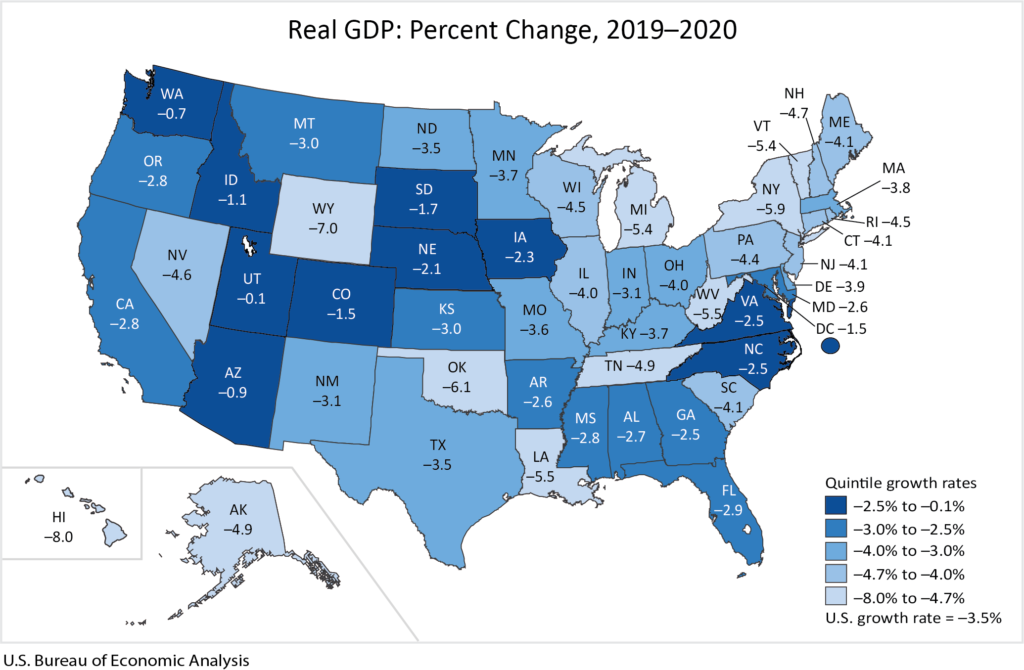National data show Nebraska’s economic resilience in 2020
Unemployment figures for the states were released for February 2021. Nebraska remains one of the national leaders at only 3.1% unemployment, following Utah and South Dakota at 3% and 2.9%, respectively.
This is 0.1% points down from January and 0.1% up from the unemployment rate in Nebraska before the pandemic in February 2020. In February 2021, 32,018 people were unemployed statewide, which is 680 more people than the same month one year ago. This indicates that Nebraska as a whole is not yet at pre-pandemic levels with regards to employment, but most states remain in the same situation.
When looking at regional summaries within the state of Nebraska, we can see which areas have been hardest hit and which are rebounding from an unemployment perspective.
- Columbus (Platte County) – 2.7% or 473 people
- Fremont (Dodge County) – 3.3% or 681 people
- Hastings (Adams County) – 3.2% or 529 people
- Kearney (Buffalo & Kearney Counties) – 2.6% or 799 people
- Lexington (Dawson & Gosper Counties) – 2.9% or 407 people
- Norfolk (Madison, Pierce & Stanton Counties) – 3.9% or 1,045 people
- North Platte (Lincoln, Logan & McPherson Counties) – 2.8% or 527 people
- Red Willow-Hitchock (Red Willow & Hitchcock Counties) – 2.4% or 174 people
- Scottsbluff (Scotts Bluff & Sioux Counties) – 3.5% or 661 people
More heavily-populated areas of the state did not do as well in comparison. Lincoln’s metropolitan area saw its unemployment rate increase from January 2021, to 3.6%, with 6,538 people unemployed. Omaha is in a similar position, increasing to 3.9% with 19,031 people unemployed. While less people are unemployed in the Grand Island area, the area followed its larger counterparts by also increasing its unemployment rate from last month to 3.9% or 1,692 people.
In addition to the Bureau of Labor Statistics releasing data, the Bureau of Economic Analysis (BEA) released data on the growth of states’ Gross Domestic Product.
The nation as a whole saw a 4.3% increase in the annual rate of GDP for the fourth quarter of 2020. According to BEA, “Finance and insurance; healthcare and social assistance; and administrative and support and waste management and remediation services were the leading contributors to the increase in real GDP nationally.”

Compared to the third quarter of 2020, Nebraska’s economy grew by 6.3%, which was the 6th highest in the nation. The percentage in real GDP for the fourth quarter ranged from 9.9% in South Dakota to 1.2% in the District of Columbia. All 50 states saw growth in the fourth quarter of 2020.
This growth, however, was not enough to offset the losses experienced earlier in 2020. All 50 states saw overall decreased real GDP in 2020. The percent ranged from -0.1% in Utah to -8.0% in Hawaii. Nebraska posted -2.1% real GDP.

According to BEA, decreases in all 50 states saw can be attributed to the accommodation and food services, arts, entertainment, and recreation and healthcare and social assistance sectors. The reason why Utah saw the lowest decline is because they had strong construction, and finance and insurance sectors that moderated their overall decrease.
However, from a regional perspective, Nebraska did quite well among the Plains States, only being surpassed by South Dakota.
